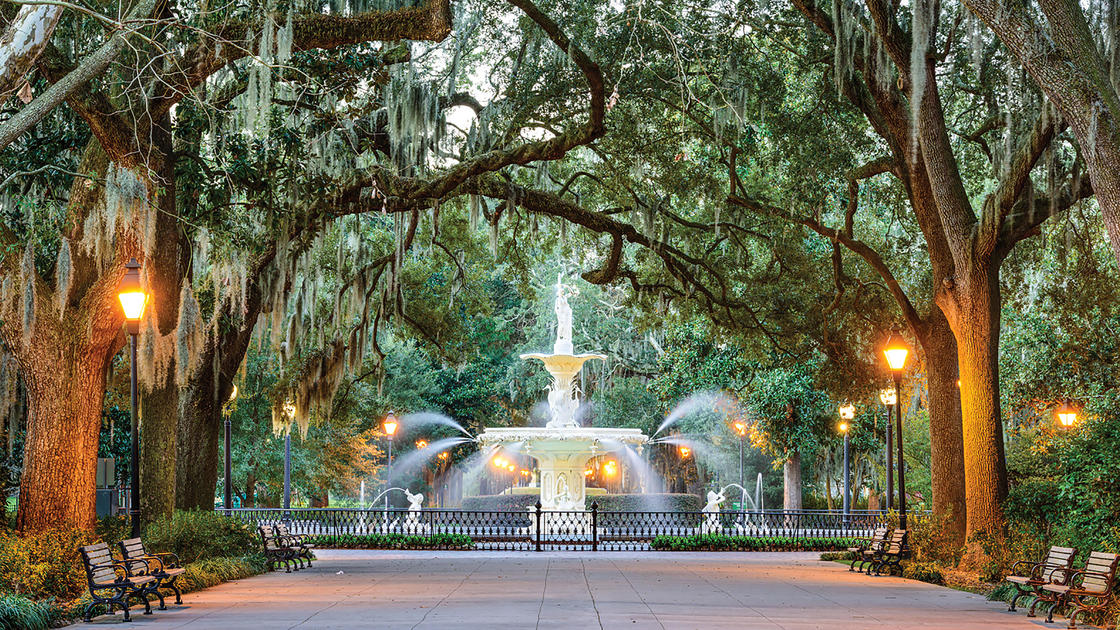Savannah residents have become experts at moving through their city covered in Spanish moss, while avoiding constant trolley rides, ghost tours, and visitors in sun hats snapping pictures of each wrought-iron balcony as if they’ve found a secret treasure. If you’re looking to experience the Hostess City like someone who knows that Spanish moss isn’t from Spain and isn’t really moss, steer clear of these expensive tourist spots that make locals wish they could haunt the tourists instead.
Trolley Tours: The On-Off History Lectures
These guided bus tours may appear to be a convenient way to explore the city, but residents are aware that you’re spending over $30 to sit in traffic while hearing tour guides repeat the same ghost stories and historical “facts” that become more exaggerated every year. The “comprehensive historic district tour” mainly consists of viewing buildings from the road while other tourists snap pictures through grimy windows. Authentic Savannah history is found in archives and local museums, not on carnival-style rides that pretend to be educational.
River Street: The Cobbled Pathway of Tourist Deception
This historic waterfront area has been entirely redeveloped into an open-air shopping mall where visitors pay high prices for t-shirts and pralines while avoiding horse-drawn carriages on uneven cobblestones that can easily hurt your feet. The so-called “authentic Southern charm” is mainly composed of chain eateries with higher costs and shops selling generic souvenirs labeled “Savannah.” Locals are aware that the true waterfront culture takes place at active docks and local seafood restaurants, not at themed dining spots that face cruise ships.
Forsyth Park: The Fountain Photo Studio
Certainly, the fountain is famous, but residents are aware that this park has transformed into an open-air venue for wedding photography, where visitors compete for the ideal Instagram picture while real parkgoers attempt to walk their dogs and toss a frisbee amidst ongoing photo sessions. The “charming Southern garden atmosphere” often means maneuvering around tripods and staged engagement shots as vendors sell expensive snacks. Locals visit the park for genuine leisure, not as a setting for social media content.
Paula Deen’s Eatery: The Grease-Soaked Travel Attraction
This renowned chef’s empire draws visitors who believe they’re savoring genuine Southern cuisine, yet they end up paying high prices for cafeteria-style meals packed with so much butter it could block the Savannah River. Residents are aware that true Southern cooking is found in family-run diners and church kitchens across the city, not at celebrity-endorsed places where the dishes are tailored for tourists who find grits unusual. The lines are unbearable and the food is only average at best.
Ghost Walks: The Evening Supernatural Show
Savannah is known as “America’s Most Haunted City,” leading to numerous ghost tour companies trying to share the most sensational supernatural tales with tourists holding plastic cups with drinks. Residents are aware that these tours repeat the same ghost stories with more exaggerated details, and many of the “haunted” places are simply bars and hotels that pay tour companies for the exposure. The actual history is far more intriguing than the fictional ghost stories.
Historic District Mansion Tours: The Pre-Civil War Imaginative Journey
These organized tours of historic homes promote themselves as a window into refined Southern life, while downplaying the harsh truth of slavery that enabled such opulence. Residents are aware that spending $25 to appreciate chandeliers and antique furnishings, with tour guides emphasizing nostalgic plantation tales, is highly questionable. The so-called “genuine antebellum experience” overlooks the individuals who constructed and managed these homes under extremely difficult circumstances.
City Market: The Gift Shopping Area
This four-block arts and crafts market draws visitors seeking “authentic Savannah art,” but residents are aware that it mainly features mass-produced items with local themes sold at high prices. The so-called “local artisans” are frequently just sellers of imported goods, and the eateries charge tourist rates for meals that would not impress those from the real South. True local art can be found in galleries across the city, where artists thrive without relying on tourist traffic.
Bonaventure Cemetery: The Midnight in the Garden Photo Session
This historic cemetery gained popularity as a tourist spot after being featured in books and films, but residents are aware that it has been taken over by tour groups and amateur photographers who treat the sacred burial grounds like a film set. The “haunting Southern Gothic atmosphere” often means avoiding other tourists taking dramatic pictures while real families attempt to visit their relatives’ graves. Locals view cemeteries as places of peace, not as tourist attractions.
The Restaurant of the Pirate’s House: The Themed Dining Adventure
This eatery promotes itself as a historic pirate tavern, but residents are aware it’s essentially a themed chain restaurant that offers subpar food at inflated prices while visitors dine in areas filled with fake nautical decorations. The “genuine 18th-century tavern experience” features a gift shop and guided tours that have no connection to real maritime history. Authentic Savannah seafood culture can be found at the docks and local fish markets, not in pirate-themed tourist restaurants.
Wormsloe Historical Site: The Instagram Ruins Adventure
Although Oak Avenue is certainly stunning, residents are aware that travelers visit Wormsloe primarily to capture images of the tree-covered entrance, overlooking the site’s true historical importance. The “ideal Southern plantation experience” emphasizes appearance over knowledge, with guests spending more time taking pictures than understanding the history of colonial Georgia. The genuine historical significance is overshadowed by the rise of photo-focused tourism.
The Judgment: Discover the True Savannah
Genuine Savannah can be found in neighborhood squares where residents come together, family-owned restaurants that draw crowds without relying on ghost tales, and cultural events that honor the city’s true multicultural background. While visitors spend large amounts on artificial Southern charm, locals are experiencing the city’s authentic culture at spots that don’t require old-fashioned Southern myths or supernatural tricks to stand out.



